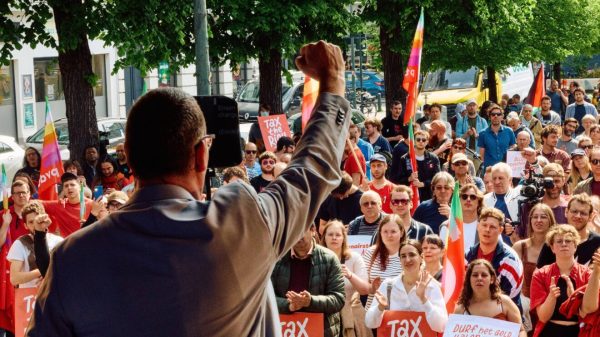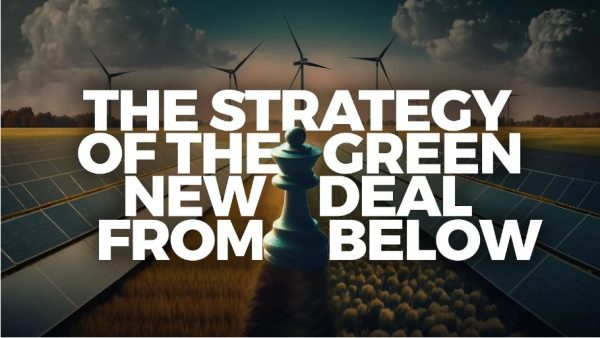By Dan DiMaggio
May 17, 2024
Source: Labor Notes

Image by UAW
North Carolina heavy truck and school bus manufacturing workers won 25 percent pay increases and ended wage tiers after an energetic contract campaign and strike threat against Daimler Truck.
The United Auto Workers unionized these plants in the 1990s and early 2000s—but since then, wages had stagnated. Starting pay was low, and the plants were stuck on different wage scales. At Thomas Built Buses, the largest school bus manufacturing site in the U.S., assembly workers topped out at $24, $5 less than their counterparts at Daimler’s Mount Holly truck plant.
The new contract establishes a common wage grid across all 7,400 workers at the four North Carolina plants, as well as parts distribution centers in Atlanta and Memphis. It’s another win for the UAW under President Shawn Fain, elected a year ago on a platform of “No Tiers. No Concessions. No Corruption.”
The union’s newfound militancy—showcased in the escalating strikes at the Big 3 last fall—was again on display. The UAW made clear that the April 26 contract expiration was a firm deadline.
The message was, “You’re either going to meet our demand or we’re going to be on strike,” said Corey Hill, president of UAW Local 3520, which represents 3,000 workers at the plant in Cleveland, North Carolina. “Tick tock Daimler, you’re on the clock.”
Workers made their own red T-shirts (many with colorful variations on the “Tick Tock” slogan), and wore them in force on Wednesdays, sharing the photos widely on social media.
Practice pickets in front of each plant in the weeks leading up to expiration drew hundreds of workers chanting, “Tick Tock! Tick Tock!” In the Mount Holly plant, workers even periodically started chanting while at work.

Image by UAW
North Carolina heavy truck and school bus manufacturing workers won 25 percent pay increases and ended wage tiers after an energetic contract campaign and strike threat against Daimler Truck.
The United Auto Workers unionized these plants in the 1990s and early 2000s—but since then, wages had stagnated. Starting pay was low, and the plants were stuck on different wage scales. At Thomas Built Buses, the largest school bus manufacturing site in the U.S., assembly workers topped out at $24, $5 less than their counterparts at Daimler’s Mount Holly truck plant.
The new contract establishes a common wage grid across all 7,400 workers at the four North Carolina plants, as well as parts distribution centers in Atlanta and Memphis. It’s another win for the UAW under President Shawn Fain, elected a year ago on a platform of “No Tiers. No Concessions. No Corruption.”
The union’s newfound militancy—showcased in the escalating strikes at the Big 3 last fall—was again on display. The UAW made clear that the April 26 contract expiration was a firm deadline.
The message was, “You’re either going to meet our demand or we’re going to be on strike,” said Corey Hill, president of UAW Local 3520, which represents 3,000 workers at the plant in Cleveland, North Carolina. “Tick tock Daimler, you’re on the clock.”
Workers made their own red T-shirts (many with colorful variations on the “Tick Tock” slogan), and wore them in force on Wednesdays, sharing the photos widely on social media.
Practice pickets in front of each plant in the weeks leading up to expiration drew hundreds of workers chanting, “Tick Tock! Tick Tock!” In the Mount Holly plant, workers even periodically started chanting while at work.
‘OWED US A RECORD CONTRACT’
Daimler workers were fired up. “This company owed us a record contract,” Hill said.
Daimler has made $20 billion in profit since the last contract in 2018, while any union gains in that deal were quickly eaten up by inflation. Meanwhile other local employers were raising pay.
“This used to be the best job around,” said welder Ben Smith, a member of UAW Local 5287 at the Thomas Built Buses plant in High Point. “That’s no longer the case. People know it’s not the only game in town—it’s a sellers’ market for labor.”
Right now there’s a strong market for heavy trucks, and the Biden administration’s infrastructure bill has allocated $5 billion for school districts to buy electric and low-emission buses.
“It was a good time to stand our ground and make the company pay up,” said Smith.
The union’s public campaign drew local media attention, as well as the support of local businesses, who hung signs showing their support for the workers. “Being public and talking about our stories, that makes these companies face what their decisions are,” said Hill.
As the clock inched toward expiration, the UAW scheduled a public announcement for 10 p.m. April 26, promising to announce a strike or a record contract. “We all assumed we were going to be getting marching orders for picketing,” Smith said.
But shortly before, the company started moving on the union’s key demands. “I think the company saw how ready we were to strike,” Smith said, “and then caved at the last minute.”
Daimler has used the threat of sending work to its two truck manufacturing plants in Mexico as a bludgeon against North Carolina workers.
“We were compared to Mexico all the time,” said UAW Local 3520 President Corey Hill: “‘How are you gonna cut costs down here? What are you going to do?’”
The company has had a plant in Santiago, in the state of Mexico, since 1991. Workers there build business-model trucks, like those used to deliver bread and beer.
In 2009, Daimler opened another plant in Saltillo, in the border state of Coahuila, which manufactures Class 8 semis—the same trucks built at the Cleveland plant. Saltillo is also home to a Stellantis truck plant; General Motors has an assembly plant in nearby Ramos Arizpe.
“Years ago, we were a premier plant, but as they built in Mexico, the wages went down,” Hill said. The company’s message was, “If you don’t like it, we’ll take it to Mexico.”
After dealing with multiple rounds of layoffs, in 2010 the UAW won some job security protection: a guarantee that a certain number of trucks would be built at the Cleveland and Mount Holly plants each day.
This year, the union was able to increase the guaranteed build rate: 80 trucks per day at the Cleveland plant (on a monthly average), up from 78 in the last contract.
Both Mexican plants are represented by the Confederation of Mexican Workers (CTM), a notoriously corrupt, employer-friendly union with deep ties to the country’s political elite. Hill hopes that Mexican workers will cast off the CTM in favor of an independent union, to fight alongside the UAW to win big improvements at Daimler Truck.
“I would love to see an independent union inside those plants,” he said.
EXPIRES IN 2028
Going forward, the UAW said wages will be negotiated as part of the master agreement, rather than in separate bargaining between the company and each local union, which Daimler had used in the past to play the locals against each other. “The company will never again use the scheme of ‘local bargaining’ to create unfair and inequitable wage increases and wage decreases based on its ability to play the local unions against each other,” said the UAW in a summary of the contract.
The wage increases will be frontloaded: everyone gets 16 percent in the first year of the contract, and many workers will receive even more. The progression to top rate is standardized and shortened from nearly six years to four. Shift premiums, formerly tiered, are now 7.5 percent across the board; tiers for vacation accrual are also eliminated.
Workers won a cost-of-living adjustment with the same formula that the UAW won at the Big 3 last fall, as well as profit-sharing. Those are both firsts at Daimler, which controls more than 40 percent of the North American market for long-haul trucks, sold under the Freightliner and Western Star brands.
The UAW won a new holiday, Juneteenth, and blocked the company’s attempt to increase workers’ health care costs.
Smith, who has been at Thomas Built for just under two years, said he’ll go from making under $24 an hour now to over $40 by the end of the contract, when he’s at top rate.
The contract was ratified in a 94 percent yes vote. It expires on March 3, 2028. The UAW has called on unions to align contract expirations for May 1, 2028 (or as near as possible), to bring maximum pressure to bear on employers and politicians.





